泡沫铜对石蜡蓄热性能影响的实验研究
陈华 柳秀丽 赵松田 李戈
天津商业大学,天津市制冷技术重点实验室
【摘 要】石蜡作为一种有机固液相变材料,因其具有高潜热值、无毒、无腐蚀、性能稳定等优点被广泛应用于热蓄存、电子冷却及建筑温控等领域。然而,因石蜡导热系数过低,导致蓄热时间过长、温差过大。为此,本实验按照1:3的比例将金属泡沫铜均匀分布在石蜡箱体中,探究泡沫铜对石蜡相变速率的影响。结果显示:加入泡沫铜后,有效的促进了石蜡的相变速率,缩短了石蜡相变的时间。同时加入泡沫铜后,内部温差明显减小,温度分布更加均匀,并且有效缓解了自然对流造成的顶部过热和底部不融化现象。
【关键词】泡沫铜;相变材料;热性能
Abstract:As an organic solid-liquid phase change material, paraffin is widely used in the fields of thermal storage, electronic cooling and building temperature control because of its high latent heat value, non-toxic, non-corrosive and stable performance. However, due to too low paraffin thermal conductivity, resulting in heat storage time is too long, the temperature difference is too large. For this purpose, the metal foam was evenly distributed in the paraffin box in proportion to 1:3, and the influence of the copper foam on the phase change rate of paraffin wax was investigated.The results show that the addition of copper foam effectively promoted the paraffin phase transformation rate and shortened the paraffin phase transition time. At the same time, after adding the foam copper, the internal temperature difference is obviously reduced, the temperature distribution is more uniform, and the top overheating and the bottom unmelting phenomenon caused by natural convection are effectively relieved.
Keywords: Copper foam; phase change material; thermal property
0 引言
随着世界经济的发展,我国经济与社会已进入大量消耗能源阶段。空调系统能耗作为主要能耗之一,其制冷运行工况所产生的冷凝热量很大,如直接排入大气,不仅浪费能源,而且会导致环境温度升高。所以,可以考虑将冷凝热回收利用[1] 。我们所熟知的空调冷凝热回收系统主要包括热回收器和蓄热装置[2] 。蓄热装置可采用水蓄热式和相变蓄热式两种形式,水蓄热式存在系统体积庞大、输入功率大等问题,而相变式蓄热式既解决了热水供应时间和数量不同步的问题,又有箱体小,灵活布置的特点[3] 。
朱家玲等[4]对地源热泵供热系统中,利用低谷电蓄能的相变蓄能装置进行研究,模拟结果显示,采用相变材料蓄热可充分利用谷电,节约运行成本,具有良好的经济性。张红瑞、廖海鲛、贺鹏和叶三宝等[5-8]分别设计并改进了相变蓄热系统,为相变蓄热系统的设计和优化提供了理论支持和参考。
同时,为提高相变材料的导热性能,很多学者对相关方面进行了研究,其主要思想是在相变材料中添加高导热系数的添加物来提高其导热系数,目前所采用的技术包括在石蜡中添加石墨[9]、翅片[10]、高导热性能的纳米纤维或纳米颗粒[11]以及泡沫金属[12、13]。
Hawlader 等[14]在实验研究中,制成一种胶囊型相变材料,将石蜡作为相变材料,明胶与阿拉伯树胶作为胶囊体材料,乙醇与甲醛作为溶剂,结果表明,该新型胶囊相变蓄热效果令人满意。
本文借鉴以往的实验研究结果,通过查阅文献[15]发现,高孔隙的泡沫金属材料是近年来开发出的一种新型材料。它采用烧结等工艺制成,含有泡沫气孔,其中的固体(铜、铝)和流体(空气、水等)导热系数相差较大,具有导热率、高比表面及高渗透性等优点[16]。故而本实验在以石蜡为主的蓄热箱中,按照1:3的比例将金属泡沫铜均匀分布在石蜡箱体中,进而研究石蜡的相变速率。得到了较好的实验结果。
1 实验系统介绍及实验方法
1.1 实验系统
本实验台可以实现单独制冷、单独制热水( 独立热回收) 、同时制冷与热回收等功能。与常规热泵系统一样,只是在原来的相变蓄热装置内添加了泡沫金属,其工作流程也同普通制冷循环类似,系统结构图如图所示。实验过程中,通过控制阀门的启闭来实现制冷,蓄热等多个功能。
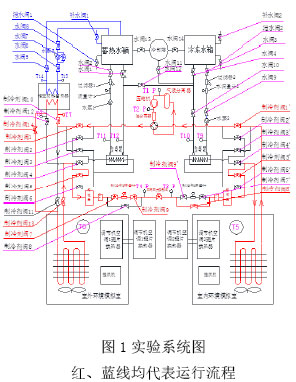
1.2 实验方法
实验中应用的纯石蜡,其物性TA-Q200型差扫描测量仪(DSC)测定,测得的石蜡熔点为60~65℃,固体状态密度为91㎏· 。实验中的泡沫铜参数如表1。
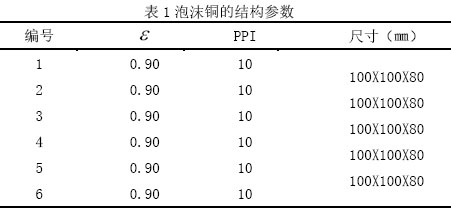
注:表中ε表示铜泡沫孔隙率,PPI为铜泡沫孔密度。
金属泡沫铜及温度测点图分布如图2:
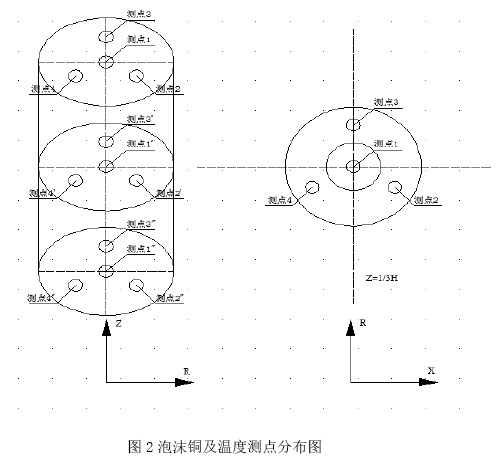
实验测得的各测点温度变化情况:左侧为蓄热箱中只为纯石蜡的图像,右侧为蓄热箱中加入金属泡沫铜的图像
2 实验结果分析
图3、图4、图5及图6分别对比了蓄热箱中只放纯石蜡与石蜡中加入金属泡沫铜后蓄热箱中上、中、下及中轴各测点石蜡融化过程中温度随时间的变化。
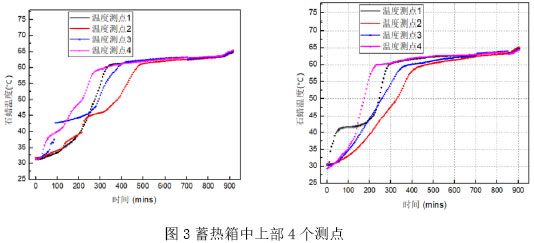
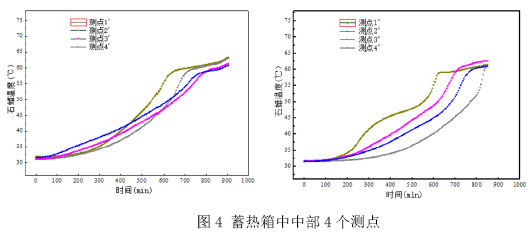
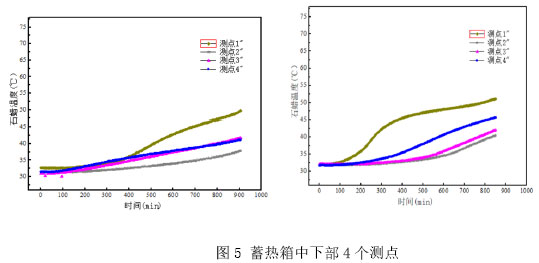
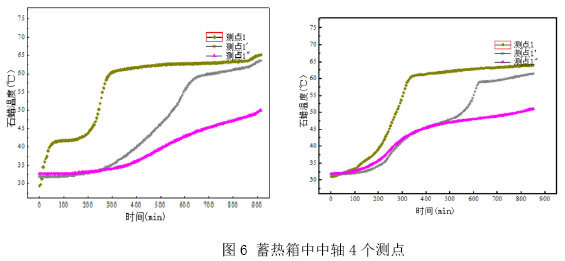
总体来看,可以看到,纯石蜡相变过程中,测点温度曲线在60~65℃之间升温缓慢,表明在整个融化升温过程中,该温度区内吸热明显。
横向来看,通过两两图像对比,可以看到,加入金属泡沫后,在前三百分钟内石蜡快速吸热,温度升高,上中下及中轴的每个测点相对溶解时间都缩短,右侧图线斜率明显大于左侧,吸热速率明显加快,达到熔点的时间明显短于纯石蜡。
纵向来看,左侧纯石蜡蓄热箱中,各测点温差较大,顶部测点由于强烈的自然对流过程,升温较快,可快速完成相变过程,而底部测点在整个过程中均未达到相变温度,内部温度分布也及其不均。而右侧部分,再按照1:3的比列加入金属泡沫铜后,竖直方向上,各测点升温曲线相对同步,均可较快达到融化温度,从侧面验证了在石蜡中加入金属泡沫铜有效抑制了自然对流作用,使得导热占据主导。
3 实验结论
通过在石蜡蓄热箱中加入金属泡沫铜,观察泡沫金属对石蜡蓄热过程性能影响的实验,得到如下结论:
(1)金属泡沫铜加入到石蜡中大大增强了传热性能,缩短了石蜡融化时间,提高了石蜡的蓄热性能。
(2)石蜡中加入金属泡沫铜,提高了温度场内的温度均匀性,使得热量能迅速被相变材料所吸收,减弱了自然对流的影响,有效缓解了蓄热箱中上下中等各部融化不均的现象。
参考文献:
[1] 章学来,于树轩,林原培,等. 相变蓄热冷凝热回收实验研究[J]. 化工学报,2010,61 ( Suppl. 2) : 43-48.( Zhang Xuelai,Yu Shuxuan,Lin Yuanpei,et al. Experi-ment research on heat recovery of condensation with phase change thermal storage[J].CIESC Journal,2010,61( Suppl.2) : 43-48.)
[2] 史德福,陈华,黄耀坤. 带冷凝热回收的家用空调器的研究[J]. 低温与超导,012,40( 5) : 63-67.( Shi Defu,Chen Hua,Huang Yaokun.Study on domestic air con-ditioner with condensing heat recovery[J].Cryogenics and Superconductivity,2012,40( 5) : 63-67.)
[3] 周楚,陈华,史德福,等. 相变蓄热式热泵热水器性能实验研究[J]. 建筑科学,2014,30 ( 4) : 5-9. ( ZhouChu,Chen Hua,Shi Defu, et al. Experimental study onperformance of phase-transition thermal-storage heat pumpwater heater[J].Building Science,2014,30( 4) : 5-9)
[4] 朱家玲,李慧,张伟. 螺旋管式相变蓄热过程的数值模拟与系统优化[J]. 天津大学学报,2012,45 ( 10) :875-880. ( Zhu Jialing,Li Hui,Zhang Wei. Numerical simulation and optimization of phase change heat storageprocess with spiral pipe[J].Journal of Tianjin University,2012,45( 10) : 875-880.)
[5] 张红瑞. 空调废热回收热泵关键技术的研究[D]. 济南: 山东建筑大学,2010.
[6] 廖海鲛,凌祥. 高温肋板式蓄热器蓄/放热特性的数值模拟[J]. 太阳能学报,2010,31( 3) : 345-350. ( Liao Haijiao,Ling Xiang. Numerical simulation of phase change heat trans-fer in high temperature fin-plate thermal storage[J].Acta Energiae Solaris Sinica,2010,31( 3) : 345-350. )
[7] 贺鹏,冯毅. 相变蓄热体的热工特性数值模拟[J]. 低温与超导,2012,40( 11) : 80-84.(He Peng,Feng Yi.Numerical simulation on thermal performance of the regen-erator with phase chang[J].Cryogenics and Supercon-ductivity,2012,40( 11) : 80-84.)
[8] 叶三宝,刁彦华,赵耀华. 新型平板热管相变蓄热器蓄放热性能分析[J]. 电力建设,2014,35( 7) : 136-140.( Ye Sanbao,DiaoYanhua,ZhaoYaohua.Heat storage-release property of phase-change thermal storage systemwith new flat heat pipe[J].Electric Power Construction,2014,35( 7) : 136-140.)
[9] Lafdi, K., Mesalhy, O. and Elgafy, A., Merits of employing foam encapsulated phase change materials forpulsed power electronics cooling applications, ASME J. Electrn. Packag. 2008, 130(2): 0210041 – 0210048
[10] 刘津丞,袁益超,徐世祥等H形鳍片片管束传热与阻力特性实验研究[J]上海理工大学学报,2004,26(5):457-460.
[11] Leland, J. and Recktenwald, G., Optimization of a phase change heat sink for extreme environments, Proc SEMITHERM, 2003: 351-356.
[12] Kim, S. and Drazal, L. T., High latent heat storage and high thermal conductive phase change materials
[13] Weinstein, R. D., Kopec, T. C., Fleischer, A. S., D’Addio, E. and Bessel, C. A., The experimentalexploration of embedding phase change materials with graphite nanofibers for the thermal management ofelectronics, J. Heat Transfer 2008, 130: 0424051-0424058.
[14] Hawlader,Zhu H J.Encapsulated phase change materialsfor thermal energy storage: experiments and simulation[J].International Journal of Energy Research,2002,26( 2) : 159-171.
[15] Yang Xiaoping (杨小平),Yang Xiaoxi (杨晓西), Ding Jing (丁静). The thermal analysis of porous medium for high-temperature thermal storage [J]. Journal of Engineering Thermophysics (工程热物理学报), 2012, 33 (3):477-480
[16] YAO Y., WU H., LIU Z. A new prediction model for the effective thermal conductivity of high porosity open-cell metal foams [J]. International Journal of Thermal Sciences, 2015, 97: 56-67.
备注:本文收录于《建筑环境与能源》2018年10月刊总第15期(第21届暖通空调制冷学术年会文集)。
版权归论文作者所有,任何形式转载请联系作者。